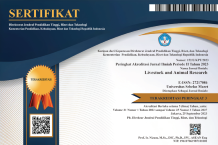Evaluation of nutrient content and in-vitro gas production of complete feed based on corn stover (Zea mays) supplemented by mimosa powder and myristic acid
Abstract
Objective: The purpose of this research was to evaluate the effect supplementation of mimosa powder as a source of condensed tannins and a single fatty acid, myristic acid, in a complete feed based on corn stover (Zea mays) using the in-vitro gas production method. This research has been carried out at the Animal Nutrition and Food Laboratory, Faculty of Animal Husbandry, Brawijaya University. The time of the research was conducted in August until December 2019.
Methods: The experimental design used randomized complete block design by ANOVA consisting four treatments and three replications which were P1= a complete feed based on corn stover (Zea mays) as control Diet (CD) (40% corn stover + 60 % concentrate), P2= (CD) + Mimosa Powder(MP) 1.5 %/kg DM + myristic acid (MA)2% /kg DM, P3= CD + MP 1.5 % /kg DM + MA 3% /kg DM, and P4= CD + MP 1.5 %/kg DM + MA 4 %/kg DM.
Results: The results showed that the treatments affected total gas production (p<0.01). The highest value for total gas production was found in P1 (86.67 ml/500 mg DM) and the lowest was found in P3 (73.30 ml/500 mg DM). The results showed that gas production decreased concurrently with the increase of MA level. In vitro methane gas and carbon dioxide production was showed different (p<0.05) from the control treatment. The lowest concentration of methane production was in P4 (82863.07 ppm) and the highest concentration was in treatment P1 86530.89 ppm. The highest total carbon dioxide content was P1 (436711.57 ppm) and the lowest concentration was P3 (350287.72 ppm).
Conclusions: The results of the research concluded that the addition of mimosa powder and 3 different levels of myristic acid in a complete feed based on corn stover can increase the nutritional value of a complete feed and reduce the production of methane gas.
Keywords
Full Text:
PDFReferences
BPS. Produksi jagung nasional 2018 [Internet]. Badan Pusat Statistik (BPS); c2018 [cited 2019 August 4]. Available from: https://bps.go.id/linkTableDinamis/view/id/868.
Umiyasih, U. and Y. N. Anggraeny. 2005. Evaluasi limbah dari beberapa varietas jagung siap rilis sebagai pakan sapi potong. Pros. Sem. Nas. Tek. Pet. Vet, p. 125-130.
Gao, J. L, P. Wang, C. H. Zhou, P. Li, H. Y. Tang, J. B. Zhang, and Y. Cai. 2019. Chemical composition and in vitro digestibility of corn stover during field exposure and the fermentation characteristics of silage prepared with microbial additives. Asian-Austral. J. Anim. 32:1854-1863. doi:10.5713/ajas.18.0886.
Chagunda, M. G. G., J. F. Flockhart, and D. J. Roberts. 2010. The effect of forage quality on predicted enteric methane production from dairy cows. Int. J. Agr. Sustain. 8:250-256. doi:10.3763/ijas.2010.0490.
Animut, G., R. Puchala, A. L. Goetsch, A. K. Patra, T. Sahlu, V. H. Varel, and J. Wells. 2008. Methane emissions by goats consuming diets with different levels of condensed tannins from lespedeza. Anim. Feed Sci. Tech. 144:212-227. doi:10.1016/j.anifeedsci.2007.10.014.
Sahoo, A., B. Singh, and T. K. Bhat. 2010. Effect of tannins on In vitro ruminal protein degradability of various tree forages. Livestock Research for Rural Development. 22:119.
Mukmin, A., H. Soetanto, Kusmartono, and Mashudi. 2014. Produksi gas in vitro asam amino metionin terproteksi dengan serbuk mimosa sebagai sumber condensed tannin (CT). Ternak Tropika. 15: 36-43.
Dohme, F. A. Machm¨uller, A. Wasserfallen, and M. Kreuzer. 2001. Ruminal methanogenesis as influenced by individual fatty acids supplemented to complete ruminant diets. Lett. Appl. Microbiol. 32:47-51. doi:10.1046/j.1472-765x.2001.00863.x.
Soliva, C. R., L. Meile, I. K. Hindrichsen, M. Kreuzer, and A. Machmuller, 2004. Myristic acid supports the immediate inhibitory effect of lauric acid on ruminal methanogens and methane release. Anaerobe. 10:269-276. doi:10.1016/j.anaerobe.2004.06.003.
Sitoresmi, P. D, L. Y. Mira, and H. Hartadi. 2009. Pengaruh penambahan minyak kelapa, minyak biji bunga matahari, dan minyak kelapa sawit terhadap penurunan produksi metan di dalam rumen secara in vitro. Buletin Peternakan. 33:96-105. doi:10.21059/buletinpeternak.v33i2.122.
Siregar, H. A., H. Y. Rahmadi, S. Wening, and E. Suprianto. 2018. Komposisi asam lemak dan karoten kelapa sawit elaeis oleifera. interspesifik hibrida dan pseudo-backcross pertama di Sumatra Utara. Jurnal Penelitian Kelapa Sawit. 26:91-101.
Dohme, F., A. Machmüller, A. Wasserfallen, and M. Kreuzer. 2000. Comparative efficiency of various fats rich in medium-chain fatty acids to suppress ruminal methanogenesis as measured with RUSITEC. Can. J. Anim. Sci. 80:473-484.
Khatiwada, D., C. Palm, and S. Silveira. 2018. Evaluating the palm oil demand in Indonesia: production trends, yields, and emerging issues. Biofuels. 2:1759-7277. doi:10.1080/17597269.2018.1461520.
Menke, K. H., L. Raab, A. Salewski, H. Steingass, D. Fritz, and W. Schneider. 1979. The estimation of the digestibility and metabolisable energy content of ruminant feedingstuffs from the gas production when they are incubated with rumen liquor. J. Agric. Sci. 93:217-222. doi:10.1017/S0021859600086305.
Li, H. Y., L. Xu, W. J. Liu, M. Q. Fang, and N. Wang. 2014. Assessment of the nutritive value of whole corn stover and its morphological fractions. Asian-Austral. J. Anim. 27:194-200. doi:10.5713/ajas.2013.13446.
Biyatmoko, D. 2014. Acid detergent (ADF) and neutral detergent fiber (NDF) profiles of rice straw fermentation products using rumen liquid microbes. Media Sains. 7:7-11.
Phuong, H. N., N. C. Friggens, J. M. de Boer, and P. Schmidely. 2013. Factors affecting energy and nitrogen efficiency of dairy cows: a meta-analysis. J. Dairy Sci. 96: 7245-7259. doi:10.3168/jds.2013-6977.
Enjalbert, F., S. Combes, A. Zened, and A. Meynadier. 2017. Rumen microbiota and dietary fat: a mutual shaping. J. Appl. Microbiol. 123:782-797. doi:10.1111/jam.13501.
Soeparno. 1998. Ilmu dan teknologi daging. Gadjah Mada University Press, Yogyakarta
Suharti, S., A. R. Nasution, D. N. Aliyah, and N. Hidayah. 2015. Potensi minyak kanola dan flaxseed terproteksi sabun kalsium untuk mengoptimalkan fermentasi dan mikroba rumen sapi potong secara in vitro. Pros. Sem. Nas. Mas. Biodiver. Indonesia. 1:89-92.
Chan, S. C., J. T. Huber, K. H. Chen, J. M. Simas, and Z. Wu. 1997. Effects of ruminally inert fat and evapprative cooling on dairy cows in hot environmental temperature. J. Dairy Sci. 80:1172-1178. doi:10.3168/jds.S0022-0302(97)76044-2.
Van Nevel, C. J., S. De Smet, and D. I. Demeyer. 1993. Digestion in defaunated and refaunated sheep fed soybean oil hydrolisate or crushed toasted soybeans. Neth. J. Agri. Sci. 41:205-219. doi:10.18174/njas.v41i3.620.
Makkar, H. P. S. 2003. Determination of hydrolysable tannins (Gallotannins and Ellagitannins) after reaction with potassium iodate. In: Quantification of tannins in tree and shrub foliage. Springer Science and Business Media B.V. Netherlands. p. 59–61.
Lavrencic, A., A. Levart, I. J. Košir, and A. Čerenak. 2015. In vitro gas production kinetics and short-chain fatty acid production from rumen incubation of diets supplemented with hop cones (Humulus lupulus L.). Animal. 9:576-581. doi:10.1017/S1751731114002936.
Odongo, N. E., R. Bagg, R. Vessie, P. Dick, M. M. Or-Rashid, S. E. Hook, J. T. Gray, E. Kebreab, J. France, and B. W. McBridge. 2007. Long-term effects of feeding monensin on methane production in lactating dairy cows. J. Dairy Sci. 90:1781-1788. doi:10.3168/jds.2006-708.
Jeyanathan, J., C. Martin, and D. Morgavi. 2014. The use directed-fed microbals for mitigation of ruminant methane emissions: A review. Animal. 8:250-261.203. doi:10.1017/S1751731113002085.
Jordan, E., D. K. Lovett, F. J. Monahan, J. Callan, B. Flynn, and F. P. O’Mara. 2006. Effect of refined coconut oil or copra meal on methane output and on intake and performance of beef heifers. J. Anim. Sci. 84:162-170. doi:10.2527/2006.841162x.
Hristov, A. N., M. Ivan, and T. A. McAllister. 2004. In vitro effects on individual fatty acids on protozoal numbers and on fermentation products in ruminal fluid from cattle fed a high concentrate, barley-based diet. J. Anim. Sci. 82:2693-2704. doi:10.2527/2004.8292693x.
Hristov, A. N., M. Ivan, and T. A. McAllister. 2004. In vitro effects on individual fatty acids on protozoal numbers and on fermentation products in ruminal fluid from cattle fed a high concentrate, barley-based diet. J. Anim. Sci. 82:2693–2704. doi:10.2527/2004.8292693x.
Refbacks
- There are currently no refbacks.










